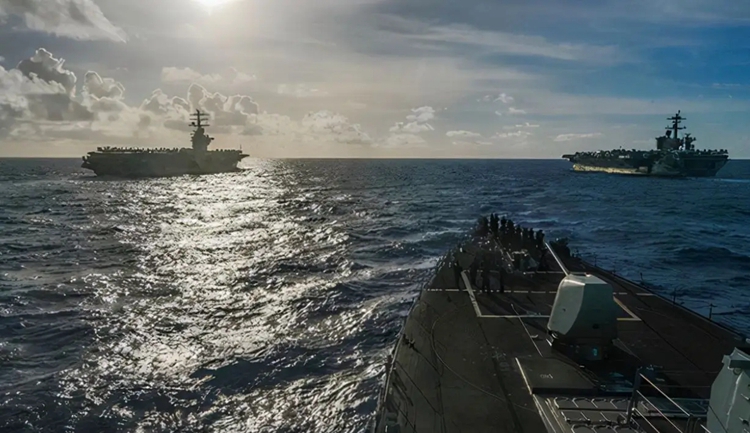The outbreak of the Red Sea crisis in November last year, its direct impact is to reduce merchant shipping activities in the Red Sea waters, resulting in capacity reduction, freight prices have made the stability of the global supply chain impact. Recently, the Danish "Maritime Intelligence" consulting analysis, the current global supply chain damage has exceeded the new crown of the early stage of the epidemic, the reason is that in December 2023 the weekly capacity index of the Red Sea (57%) has exceeded the March 2020 the new crown of the early stage of the epidemic drop (47%). Shipping companies such as Maersk have said that it could take months to reopen Red Sea routes. John Llewellyn, former chief economist of the Organization for Economic Cooperation and Development, has argued that the Red Sea situation could spread to the Strait of Hormuz and the wider Middle East.
According to Clarkson research statistics, the suspension of the Red Sea route container capacity accounted for 74% of the total global container capacity, the world's top ten shipping companies in six shipping companies have announced the suspension of the Red Sea route transportation. Currently there are two main alternative programs: one is to bypass the Cape of Good Hope in Africa to reach Europe. Compared with the Red Sea route, bypassing the Cape of Good Hope route will make the transportation distance increased by about 30%, the voyage increased by about 7 to 21 days. This, coupled with the continuing drought in the Panama Canal, another important global canal, also increases the level of congestion in the Cape of Good Hope, Africa. The second is to switch to overland transportation, but the availability of alternatives is very limited. Overland transportation from the Gulf to the Mediterranean can only replace about 3% of maritime traffic.
Impact on global supply chain

Zhou Jingtong, a researcher at the Bank of China Research Institute, analyzed that the Red Sea crisis has drastically reduced container traffic in the Red Sea waters.2023 In December, the average daily traffic in the Red Sea was only about 200,000 containers, a drop of 60% from November. According to Vortexa data, as of January 19, 2024, the number of tankers passing through the Red Sea dropped by 25% compared to the same period last year. Cargo tonnage since December 2023 has dropped significantly in terms of Gulf of Aden shipping volumes. Compared to December 2022, the daily gross tonnage of cargo entering the Gulf of Aden in December 2023 decreased by an average of 18.4%. Compared to early December 2023, daily gross tonnage of cargo entering the Gulf of Aden has fallen by an average of 43% between December 17 and 20, with container ships down 82% and bulk carriers and tankers combined down 21%; the average number of new vessels per day is 63, a decline of 25%.
Under the high tension of global shipping, shippers have to wait for the return of cargo ships in order to obtain free positions. In January-February each year, European and American importers tend to concentrate on ordering. Coupled with factory shutdowns during the Lunar New Year, Chinese exporters tend to concentrate shipments before the holiday, which increases global shipping tension and puts some multinationals at risk of supply chain disruptions. In the consumer goods retail industry, home furnishing giant IKEA issued a warning on December 20, 2023 for delayed delivery of some products, and since then, British clothing retailers Next and Crocs have issued similar warnings. In the automotive industry, Tesla announced the suspension of production at its Berlin, Germany, plant from January 29, 2024 until February 12 due to a shortage of some parts; Volvo suspended production at its Ghent, Belgium, plant for three days; and the Strandis Group switched to airfreight to address the risk of disruption in its supply chain.
The Red Sea crisis may have longer-term implications for supply chain stability. This is because several ports along the Cape of Good Hope, such as South Africa, Mauritius, and Spain's Canary Islands, are struggling to meet the surge in fuel and infrastructure demand due to the detour, while several ports along the Mediterranean are experiencing cold spells. In the future, ports along the Cape of Good Hope may strengthen their infrastructure, the global shipping layout may change, and trading companies may need to adjust their supply chains to the new shipping landscape, but such adjustments often take a long time.
Pushing up commodity prices
Zhou Jingtong predicts that localized supply chain disruptions brought about by the Red Sea crisis will increase the risk of recurring inflation in major global economies.

First, the oil transportation obstruction will push up global energy prices. The Red Sea region is an important channel for Middle East oil exports. in December 2023, Middle East crude oil exports averaged about 570,000 barrels per day, compared with October 2023 (1.07 million barrels), a sharp drop of nearly 50%. In addition, Saudi Arabia and Iraq, totaling nearly 9 million barrels of oil, could face transportation delays as tankers are rerouted around the Cape of Good Hope in Africa. Currently, international oil prices are up from early January 2024. on January 20, Brent crude was at $78.6/bbl, up about 4% from its early January low. On the same day, U.S. crude oil futures settled at $73.25/bbl, up about 4.7% from the early January low.
Secondly, the transportation of agricultural products is hindered or lifted prices on the consumer side. On the one hand, food transportation on the time requirements are higher, rerouted to the Cape of Good Hope in Africa need to pass through the southern hemisphere in the summer, the risk of food deterioration increased, the consumer side of the reduction in the supply of food. On the other hand, food exported to Europe is mainly quoted in the form of FOB (Free on Board), and European traders are bound to pass on the additional transportation costs directly to consumers, pushing up the consumer price level.
Rising energy and agricultural prices may expose major developed economies to the risk of recurring inflation.2023 In December, the EU HICP rose 3.4% year-on-year, a growth rate of 0.3 percentage points higher than the previous month; the U.S. PCE rose 0.2% year-on-year, a rise of 0.3 percentage points from the previous month. Analysis by the Oxford Economics Institute in the UK suggests that there is an upside risk to current global prices, and that if container shipping costs remain at current levels, this could push global inflation up by about 0.6 percentage points. If the Red Sea crisis persists, this will significantly increase the risk of repeated global inflation, which in turn will delay the time and pace of the shift in monetary policy of the U.S., Europe and other central banks in 2024, and will bring greater uncertainty to global economic growth, financial market stability and so on.

